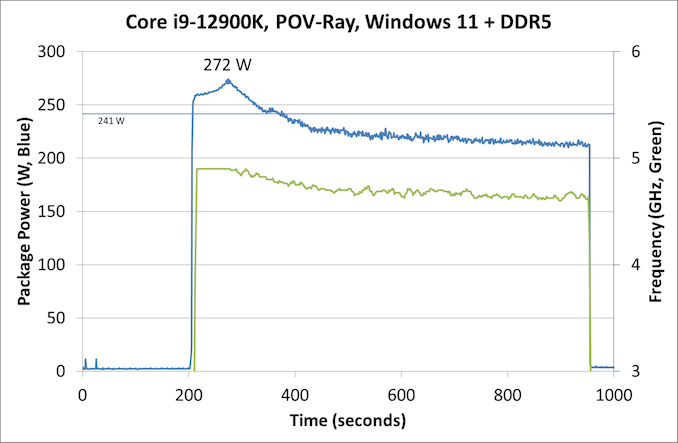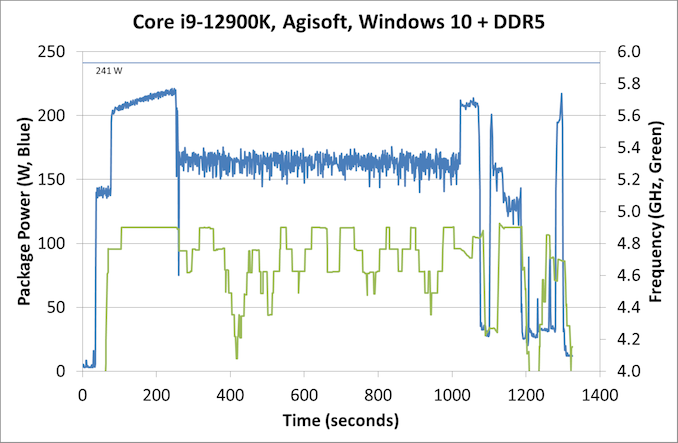The Intel 12th Gen Core i9-12900K Review: Hybrid Performance Brings Hybrid Complexity
by Dr. Ian Cutress & Andrei Frumusanu on November 4, 2021 9:00 AM ESTPower: P-Core vs E-Core, Win10 vs Win11
For Alder Lake, Intel brings two new things into the mix when we start talking about power.
First is what we’ve already talked about, the new P-core and E-core, each with different levels of performance per watt and targeted at different sorts of workloads. While the P-cores are expected to mimic previous generations of Intel processors, the E-cores should offer an interesting look into how low power operation might work on these systems and in future mobile systems.
The second element is how Intel is describing power. Rather than simply quote a ‘TDP’, or Thermal Design Power, Intel has decided (with much rejoicing) to start putting two numbers next to each processor, one for the base processor power and one for maximum turbo processor power, which we’ll call Base and Turbo. The idea is that the Base power mimics the TDP value we had before – it’s the power at which the all-core base frequency is guaranteed to. The Turbo power indicates the highest power level that should be observed in normal power virus (usually defined as something causing 90-95% of the CPU to continually switch) situation. There is usually a weighted time factor that limits how long a processor can remain in its Turbo state for slowly reeling back, but for the K processors Intel has made that time factor effectively infinite – with the right cooling, these processors should be able to use their Turbo power all day, all week, and all year.
So with that in mind, let’s start simply looking at the individual P-cores and E-cores.
Listed in red, in this test, all 8P+8E cores fully loaded (on DDR5), we get a CPU package power of 259 W. The progression from idle to load is steady, although there is a big jump from idle to single core. When one core is loaded, we go from 7 W to 78 W, which is a big 71 W jump. Because this is package power (the output for core power had some issues), this does include firing up the ring, the L3 cache, and the DRAM controller, but even if that makes 20% of the difference, we’re still looking at ~55-60 W enabled for a single core. By comparison, for our single thread SPEC power testing on Linux, we see a more modest 25-30W per core, which we put down to POV-Ray’s instruction density.
By contrast, in green, the E-cores only jump from 5 W to 15 W when a single core is active, and that is the same number as we see on SPEC power testing. Using all the E-cores, at 3.9 GHz, brings the package power up to 48 W total.
It is worth noting that there are differences between the blue bars (P-cores only) and the red bars (all cores, with E-cores loaded all the time), and that sometimes the blue bar consumes more power than the red bar. Our blue bar tests were done with E-cores disabled in the BIOS, which means that there might be more leeway in balancing a workload across a smaller number of cores, allowing for higher power. However as everything ramps up, the advantage swings the other way it seems. It’s a bit odd to see this behavior.
Moving on to individual testing, and here’s a look at a power trace of POV-Ray in Windows 11:
Here we’re seeing a higher spike in power, up to 272 W now, with the system at 4.9 GHz all-core. Interestingly enough, we see a decrease of power through the 241 W Turbo Power limit, and it settles around 225 W, with the reported frequency actually dropping to between 4.7-4.8 GHz instead. Technically this all-core is meant to take into account some of the E-cores, so this might be a case of the workload distributing itself and finding the best performance/power point when it comes to instruction mix, cache mix, and IO requirements. However, it takes a good 3-5 minutes to get there, if that’s the case.
Intrigued by this, I looked at how some of our other tests did between different operating systems. Enter Agisoft:
Between Windows 10 and Windows 11, the traces look near identical. The actual run time was 5 seconds faster on Windows 11 out of 20 minutes, so 0.4% faster, which we would consider run-to-run variation. The peaks and spikes look barely higher in Windows 11, and the frequency trace in Windows 11 looks a little more consistent, but overall they’re practically the same.
For our usual power graphs, we get something like this, and we’ll also add in the AVX-512 numbers from that page:

Compared to Intel’s previous 11th Generation Processor, the Alder Lake Core i9 uses more power during AVX2, but is actually lower in AVX-512. The difficulty of presenting this graph in the future is based on those E-cores; they're more efficient, and as you’ll see in the results later. Even on AVX-512, Alder Lake pulls out a performance lead using 50 W fewer than 11th Gen.
When we compare it to AMD however, with that 142 W PPT limit that AMD has, Intel is often trailing at a 20-70 W deficit when we’re looking at full load efficiency. That being said, Intel is likely going to argue that in mixed workloads, such as two software programs running where something is on the E-cores, it wants to be the more efficient design.














474 Comments
View All Comments
mode_13h - Saturday, November 6, 2021 - link
> A competent CEO wouldn’t have allowed this situation to occur.And you'd know this because... ?
> This is an outstanding example of how the claim that only engineers
> make good CEOs for tech companies is suspect.
You're making way to much of this.
I don't know who says "only engineers make good CEOs for tech companies". That's an absolutist statement I doubt anyone reasonable and with suitable expertise to make such proclamations ever would. There are plenty of examples where engineers in the CEO's chair have functioned poorly, but also many where they've done well. The balance of that particular assessment doesn't hang on Gelsinger, and especially not on this one issue.
Also, your liberal arts degree is showing. I'm not casting any aspersions on liberal arts, but when you jump to attack engineers for stepping outside their box, it does look like you've got a big chip on your shoulder.
Oxford Guy - Sunday, November 7, 2021 - link
‘Also, your liberal arts degree is showing. I'm not casting any aspersions on liberal arts’Your assumption about my degrees is due to the fact that I understand leadership and integrity?
mode_13h - Sunday, November 7, 2021 - link
> Your assumption about my degrees is due to the fact that I understand leadership and integrity?Yes, exactly. It's exactly your grasp of leadership and integrity that I credit for your attack on engineers stepping outside their box. Such a keen observation. /s
(and that's how you "sarcasm", on the Internet.)
kwohlt - Sunday, November 7, 2021 - link
I'm not sure how familiar you are with CPU design, but Alder Lake was taped in before Gelsinger took over. The design was finalized, and there was no changing it without massive delays. For the miniscule amount of the market that insists on AVX-512 for the consumer line, it can be implemented after disabling E Cores. AVX-512 just doesn't work on Gracemont, so you can't have both Gracemont and AVX-512 simultaneously. CPU designs take 4 years. You'll see the true impact of Gelsingers leadership in a few years.SystemsBuilder - Saturday, November 6, 2021 - link
MS and intel tried to sync their plans to launch Windows 11 and Alderlake at (roughly) the same time. intel might have been rushed to lock their POR to hit Windows 11 launch. There may even be a contractual relationship between Intel and Microsoft to make sure Windows 11 runs best on Intel's Alder Lake - Intel pay MS to optimize the scheduler for Alder lake and in return Intel has to lock the Alder Lake POR maybe even up to a year go... because MS was not going to move the Windows 11 launch date.Speculation from my side of course, but I don't think I am too far off...
Oxford Guy - Saturday, November 6, 2021 - link
Such excuses don’t work.The current situation is inexcusable.
SystemsBuilder - Saturday, November 6, 2021 - link
yes it is inexcusable BUT the Pat might not have had a choice because he does not control Microsoft.Satya N. would just tell Pat we have a contract - fulfill it!
We are not going to delay Windows 11 it's shipping October 2021 so we will stick with the POR you gave us in 2020!
Satya is running a $2.52 trillion market cap company current #1 in the world
Pat is running a $206.58 billion market cap company
so guess who's calling the shots.
Pat says "ok... but maybe we can enable it for the 22H1 version of win 11, please Satya help me out here..."
in the end I think MS will do the right thing and get it to work but it might get delayed a bit.
Again, my speculation. And again, I don't think I am far off...
Oxford Guy - Saturday, November 6, 2021 - link
The solution was not to create this incompetent partial ‘have faith’ AVX-512 situation. Faith is for religion, not tech products.The solution was to be clear and consistent. For instance, if Windows is the problem then that should have been made clear. Gelsinger should have said MS doesn’t yet have its software at full compatibility with Alder Lake. He should have said it will be officially supported when Windows is ready for it.
He should have had a software utility for power users to disable the small cores in order to have AVX-512 support, or at least a BIOS option — mandated for all Alder Lake boards — that disables them as an option for those who need AVX-512.
The current situation cannot be blamed on Microsoft. Intel has the ability to be clear, consistent, and competent about its products.
Claiming that Intel isn’t a large enough entity to tell the truth also doesn’t pass muster. Even if it’s inconvenient for Microsoft to be exposed for releasing Windows 11 prematurely and even if it’s inconvenient for Intel to be exposed for releasing Alder Lake prematurely — saving face isn’t an adequate excuse for creating a situation this untenable.
Consumers deserve non-broken products that aren’t sold via smoke and mirrors tactics.
SystemsBuilder - Saturday, November 6, 2021 - link
a couple of points:- yes it would have been better to communicate to the market that AVX-512 will be enabled with 22H1 (or what ever - speculating) of windows 11 but what about making it work with windows 10 and when... i mean the whole situation it's a cluster. I do agree that the current marketing decision under Pat's what and how to communicate to the market what is happening with Alder Lake and AVX-512 and Windows 10/11 could have been handled much, much better. the way they have done it is a disaster. it's like is it in or out i mean wtf. is it strategic or not. This market communicating, related decisions and what every new agreements they need to strike with Microsoft to make the whole thing make sense is on Pat - firmly!
- i am not blaming Microsoft at all. I am mostly blaming the old marketing and the old CEO - pure incompetence for getting Intel into this situation in the first place. I don't have all the insights into Intel's internals but from an outside perspective it looks like that to me.
Oxford Guy - Saturday, November 6, 2021 - link
Gelsinger’s responsibility is to lead, not blame previous leadership.Alder Lake came out on his watch. The AVX-512 debacle, communications and lack of mandated minimum specs (official partial support for the lifetime of AL in 100% of AL boards via BIOS switch to disable small cores) happened to while he was CEO.
The lie about fusing off happened under his leadership.
We have been lied to and spacetime can’t be warped to erase the stain on his tenure.